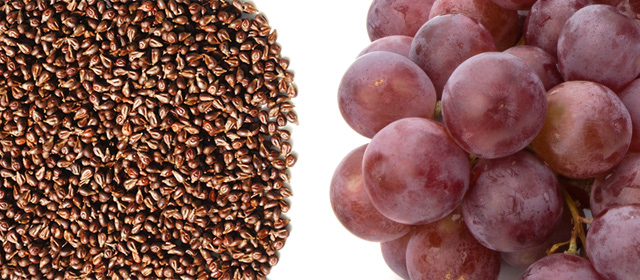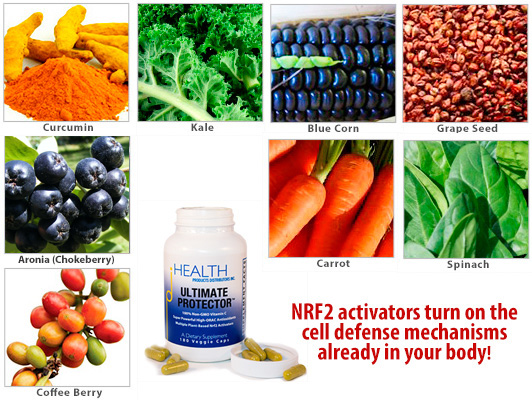 Ultimate Protector contains grape seed extract and associated oligomeric proanthocyanidins (OPCs), as well as components from 29 different fruits, vegetables, and herbs. Each of these ingredients contain substances that may be considered to be polyphenols, antioxidants and Nrf2 activators. In this article I will explore the ingredient grape seed extract which is a component of VitaBerry®Plus from Futureceuticals.
Ultimate Protector contains grape seed extract and associated oligomeric proanthocyanidins (OPCs), as well as components from 29 different fruits, vegetables, and herbs. Each of these ingredients contain substances that may be considered to be polyphenols, antioxidants and Nrf2 activators. In this article I will explore the ingredient grape seed extract which is a component of VitaBerry®Plus from Futureceuticals.
During the last 24 years I have designed more than 20 products incorporating OPCs from whole grape and grape seed extracts. Some of these products include: Antioxidant Formula, Diabetes Support Formula, Eye & Vision Formula, Joint Health Formula, Chewable Kid’s Mighty-Multi, Hank & Brian’s Mighty Multi-vite!, Mini Multi, Multi Two, OPC-C, PRO-C, Prolyt, Rejuvenate! Pro, Rejuvenate! Berries & Herbs, and Rejuvenate! Strawberry-Peach Protein Plus.
In 1993 I prepared an extensive review of OPCs including the sources of grape seed extract and pine bark extract. In this review article entitled Review of Scientific Research on Oligomeric Proanthcyanidins (OPC), I pointed out that grape seed extract consists of approximately 92% polyphenols, 32% monomers (flavan-3-ol), and 68% OPCs. OPCs consist of catechins (referring to both catechins and epicatechins) that have the peculiar property of forming polymers with themselves. When the number of connected catechins is 10 or less they are called oligomers and thus the term used is “oligomeric proanthocyanidins.” When the number of connected catechins is more than 10 the term condensed tannins is generally used. The term proanthocyanidins comes about because when these materials are subjected to 10% hydrochloric acid and heated to boiling (this is what is termed the Bate-Smith test), they yield an anthocyanidin, with its intense red coloration, and a catechin.
It has only been more recent that ORAC5.0 testing has shown that grape seed extract is one of the most powerful antioxidants known and provides excellent protection against all five of the free radical types tested for in the ORAC5.0 tests. The table shown below taken from my blog article entitled THE AMAZING HEALING POTENTIAL OF NATURAL NRF2 ACTIVATORS provides test data to support this statement.
Interestingly, we have observed that the natural plant substances with the highest ORAC5.0 values appear to be among the most effective Nrf2 activators. For example, see the table below. In particular, note that Curcumin (98%), Grape Seed Extract, Green Tea Extract, and Reservatrol which are commonly used for their excellent Nrf2 activator effects are the most powerful in-vitro antioxidants . Please note that Ultimate Protector is over 50% more powerful as an antioxidant than the best single plant ingredient.
TABLE 2: ORAC5.0™ COMPARATIVE RESULTS
| Ingredient | Peroxyl Radical | Hydroxyl Radical | Peroxy-nitrite Radical | Super- oxide Radical |
Singlet O2 Radical | Total ORAC5.0 |
|---|---|---|---|---|---|---|
| Curcumin 98% | 5,750 | 8,920 | 906 | 597 | 66,290 | 82,500 |
| Bilberry 25% | 7,000 | 25,000 | 1,000 | 16,000 | 5,000 | 54,000 |
| Cocoa | 10,000 | 28,000 | 1,000 | 11,000 | 2,000 | 52,000 |
| Grape Seed Extract | 17,000 | 47,000 | 1,000 | 25,000 | 4,000 | 94,000 |
| Green Tea Extract | 11,000 | 41,000 | 2,000 | 56,000 | 3,000 | 113,000 |
| Coffee Berry Extract | 5,000 | 29,000 | 1,000 | 1,000 | 2,000 | 38,000 |
| Mangosteen | 4,000 | 8,000 | 1,000 | 18,000 | 4,000 | 35,000 |
| Pine Bark | 7,000 | 23,000 | 1,000 | 17,000 | 2,000 | 50,000 |
| Resveratrol | 12,000 | 50,000 | 1,000 | 8,000 | 22,000 | 93,000 |
| ULTIMATE PROTECTOR™ | 6,300 | 5,900 | 2,500 | 106,000 | 52,000 | 173,000 |
Results are expressed in micro mole TE/gFrom ORAC DATABASE (INCLUDING ORAC5.0 TEST RESULTS) |
||||||
Below we provide information from several research articles that highlight some of the potential health effects of grape seed extract.
Procyanidins from Wild Grape (Vitis amurensis) Seeds Regulate ARE-Mediated Enzyme Expression via Nrf2 Coupled with p38 and PI3K/Akt Pathway in HepG2 Cells
From: http://www.ncbi.nlm.nih.gov/pmc/articles/PMC3269721/
Abstract
Procyanidins, polymers of flavan-3-ol units, have been reported to exhibit many beneficial health effects such as antioxidant and anti-carcinogenic effects. In this study, we investigated the cancer chemopreventive properties of procyanidins from wild grape (Vitis amurensis) seeds in particular their roles in inducing phase II detoxifying/antioxidant enzymes as well as in modulating the upstream kinases. Ethanolic extract of V. amurensis seeds was fractionated with a series of organic solvents and finally separated into six fractions, F1–F6. Chemical properties of the procyanidins were analyzed by vanillin assay, BuOH-HCl test, and depolymerization with phloroglucinol followed by LC/MS analysis. The F5 had the highest procyanidin content among all the fractions and strongly induced the reporter activity of antioxidant response element as well as the protein expression of nuclear factor E2-related factor (Nrf2) in HepG2 human hepatocarcinoma cells. The procyanidin-rich F5 also strongly induced the expression of the phase II detoxifying and antioxidant enzymes such as NAD(P)H:quinone oxidoreductase1 and hemeoxygenase1. Phosphorylations of the upstream kinases such as MAPKs and PI3K/Akt were significantly increased by treatment with procyanidin fraction. In addition, the procyanidin-mediated Nrf2 expression was partly attenuated by PI3K inhibitor LY294002, and almost completely by p38 inhibitor SB202190, but neither by JNK inhibitor SP600125 nor by MEK1/2 inhibitor U0126. Taken together, the procyanidins from wild grape seeds could be used as a potential natural chemopreventive agent through Nrf2/ARE-mediated phase II detoxifying/antioxidant enzymes induction via p38 and PI3K/Akt pathway.
Grape seed extract induces apoptotic death of human prostate carcinoma DU145 cells via caspases activation accompanied by dissipation of mitochondrial membrane potential and cytochrome c release.
From: http://www.ncbi.nlm.nih.gov/pubmed/12419835
Carcinogenesis. 2002 Nov;23(11):1869-76, Agarwal C1, Singh RP, Agarwal R.
Abstract
Grape seed extract (GSE), rich in the bioflavonoids commonly known as procyanidins, is one of the most commonly consumed dietary supplements in the United States because of its several health benefits. Epidemiological studies show that many prostate cancer (PCA) patients use herbal extracts as dietary supplements in addition to their prescription drugs. Accordingly, in recent years, we have focused our attention on assessing the efficacy of GSE against PCA. Our studies showed that GSE inhibits growth and induces apoptotic death of human PCA cells in culture and in nude mice. Here, we performed detailed studies to define the molecular mechanism of GSE-induced apoptosis in advanced human PCA DU145 cells. GSE treatment of cells at various doses (50-200 micro g/ml) for 12-72 h resulted in a moderate to strong apoptotic death in a dose- and time-dependent manner. In the studies assessing the apoptotic-signaling pathway induced by GSE, we observed an increase in cleaved fragments of caspases 3, 7 and 9 as well as PARP in GSE-treated cells after 48 and 72 h of treatment. Pre-treatment of cells with general caspases inhibitor, z-Val-Ala-Asp(OMe)-FMK or caspase 3-like proteases inhibitor [z-Asp(OMe)-Glu(OMe)-Val-Asp(OMe)-FMK], almost completely (approximately 90%) inhibited the GSE-induced apoptotic cell death. In a later case, GSE-induced caspase-3 activity was completely inhibited. Selective caspase 9 inhibitor [z-Leu-Glu(OMe)-His-Asp(OMe)-FMK] showed only partial inhibition of GSE-induced apoptosis whereas GSE-induced protease activity of caspase 9 was completely inhibited. Upstream of caspase cascade, GSE showed disappearance of mitochondrial membrane potential and an increase in cytochrome c release in cytosol. Together, these results suggest that GSE possibly causes mitochondrial damage leading to cytochrome c release in cytosol and activation of caspases resulting in PARP cleavage and execution of apoptotic death of human PCA DU145 cells. Furthermore, GSE-caused caspase 3-mediated apoptosis also involves other pathway(s) including caspase 9 activation.
Differential effect of grape seed extract against human non-small-cell lung cancer cells: the role of reactive oxygen species and apoptosis induction.
From: http://www.ncbi.nlm.nih.gov/pubmed/23682782
Abstract
The present study examines grape seed extract (GSE) efficacy against a series of non-small-cell lung cancer (NSCLC) cell lines that differ in their Kras and p53 status to establish GSE potential as a cytotoxic agent against a wide range of lung cancer cells. GSE suppressed growth and induced apoptotic death in NSCLC cells irrespective of their k-Ras status, with more sensitivity toward H460 and H322 (wt k-Ras) than A549 and H1299 cells (mutated k-Ras). Mechanistic studies in A549 and H460 cells, selected, based on comparative efficacy of GSE at higher and lower doses, respectively, showed that apoptotic death involves cytochrome c release associated caspases 9 and 3 activation, and poly (ADP-ribosyl) polymerase cleavage, strong phosphorylation of ERK1/2 and JNK1/2, downregulation of cell survival proteins, and upregulated proapoptotic Bak expression. Importantly, GSE treatment caused a strong superoxide radical-associated oxidative stress, significantly decreased intracellular reduced glutathione levels, suggesting, for the first time, the involvement of GSE-caused oxidative stress in its apoptotic inducing activity in these cells. Because GSE is a widely-consumed dietary agent with no known untoward effects, our results support future studies to establish GSE efficacy and usefulness against NSCLC control.
Role of oxidative stress in cytotoxicity of grape seed extract in human bladder cancer cells.
From: http://www.ncbi.nlm.nih.gov/pubmed/23831192
Food Chem Toxicol. 2013 Nov;61:187-95. doi: 10.1016/j.fct.2013.06.039. Epub 2013 Jul 3. Raina K1, Tyagi A, Kumar D, Agarwal R, Agarwal C.
Abstract
In present study, we evaluated grape seed extract (GSE) efficacy against bladder cancer and associated mechanism in two different bladder cancercell lines T24 and HTB9. A significant inhibitory effect of GSE on cancer cell viability was observed, which was due to apoptotic cell death. Cell death events were preceded by vacuolar appearance in cytoplasm, which under electron microscopy was confirmed as swollen mitochondrial organelle and autophagosomes. Through detailed in vitro studies, we established that GSE generated oxidative stress that initiated an apoptotic response as indicated by the reversal of GSE-mediated apoptosis when the cells were pre-treated with antioxidants prior to GSE. However, parallel to a strong apoptotic cell death event, GSE also caused a pro-survival autophagic event as evidenced by tracking the dynamics of LC3-II within the cells. Since the pro-death apoptotic response was stronger than the pro-survival autophagy induction within the cells, cell eventually succumbed to cellular death after GSE exposure. Together, the findings in the present study are both novel and highly significant in establishing, for the first time, that GSE-mediated oxidative stress causes a strong programmed cell death in human bladder cancer cells, suggesting and advocating the effectiveness of this non-toxic agent against this deadly malignancy.
Copyright © 2013 Elsevier Ltd. All rights reserved.
Target identification of grape seed extract in colorectal cancer using drug affinity responsive target stability (DARTS) technique: role of endoplasmic reticulum stress response proteins.
From: http://www.ncbi.nlm.nih.gov/pubmed/24724981
Abstract
Various natural agents, including grape seed extract (GSE), have shown considerable chemopreventive and anti-cancer efficacy against different cancers in pre-clinical studies; however, their specific protein targets are largely unknown and thus, their clinical usefulness is marred by limited scientific evidences about their direct cellular targets. Accordingly, herein, employing, for the first time, the recently developed drug affinity responsive target stability (DARTS) technique, we aimed to profile the potential protein targets of GSE in human colorectal cancer (CRC) cells. Unlike other methods, which can cause chemical alteration of the drug components to allow for detection, this approach relies on the fact that a drug bound protein may become less susceptible to proteolysis and hence the enriched proteins can be detected by Mass Spectroscopy methods. Our results, utilizing the DARTS technique followed by examination of the spectral output by LC/MS and the MASCOT data, revealed that GSE targets endoplasmic reticulum (ER) stress response proteins resulting in overall down regulation of proteins involved in translation and that GSE also causes oxidative protein modifications, specifically on methionine amino acids residues on its protein targets. Corroborating these findings, mechanistic studies revealed that GSE indeed caused ER stress and strongly inhibited PI3k-Akt-mTOR pathway for its biological effects in CRC cells. Furthermore, bioenergetics studies indicated that GSE also interferes with glycolysis and mitochondrial metabolism in CRC cells. Together, the present study identifying GSE molecular targets in CRC cells, combined with its efficacy in vast pre-clinical CRC models, further supports its usefulness for CRC prevention and treatment.
Polyphenolics in grape seeds-biochemistry and functionality.
From: http://www.ncbi.nlm.nih.gov/pubmed/14977436
Abstract
Grape seeds are waste products of the winery and grape juice industry. These seeds contain lipid, protein, carbohydrates, and 5-8% polyphenols depending on the variety. Polyphenols in grape seeds are mainly flavonoids, including gallic acid, the monomeric flavan-3-ols catechin, epicatechin, gallocatechin, epigallocatechin, and epicatechin 3-O-gallate, and procyanidin dimers, trimers, and more highly polymerized procyanidins. Grape seed extract is known as a powerful antioxidant that protects the body from premature aging, disease, and decay. Grape seeds contains mainly phenols such as proanthocyanidins (oligomeric proanthocyanidins). Scientific studies have shown that the antioxidant power of proanthocyanidins is 20 times greater than vitamin E and 50 times greater than vitamin C. Extensive research suggests that grape seed extract is beneficial in many areas of health because of its antioxidant effect to bond with collagen, promoting youthful skin, cell health, elasticity, and flexibility. Other studies have shown that proanthocyanidins help to protect the body from sun damage, to improve vision, to improve flexibility in joints, arteries, and body tissues such as the heart, and to improve blood circulation by strengthening capillaries, arteries, and veins. The most abundant phenolic compounds isolated from grapeseed are catechins, epicatechin, procyanidin, and some dimers and trimers.
Anti-tumor-promoting activity of a polyphenolic fraction isolated from grape seeds in the mouse skin two-stage initiation-promotion protocol and identification of procyanidin B5-3′-gallate as the most effective antioxidant constituent.
From: http://www.ncbi.nlm.nih.gov/pubmed/10469619
Abstract
Procyanidins present in grape seeds are known to exert anti-inflammatory, anti-arthritic and anti-allergic activities, prevent skin aging, scavenge oxygen free radicals and inhibit UV radiation-induced peroxidation activity. Since most of these events are associated with the tumor promotion stage of carcinogenesis, these studies suggest that grape seed polyphenols and the procyanidins present therein could be anticarcinogenic and/or anti-tumor-promoting agents. Therefore, we assessed the anti-tumor-promoting effect of a polyphenolic fraction isolated from grape seeds (GSP) employing the 7,12-dimethylbenz[a]anthracene (DMBA)-initiated and 12-O-tetradecanoylphorbol 13-acetate (TPA)-promoted SENCAR mouse skin two-stage carcinogenesis protocol as a model system. Following tumor initiation with DMBA, topical application of GSP at doses of 0.5 and 1.5 mg/mouse/application to the dorsal initiated mouse skin resulted in a highly significant inhibition of TPA tumor promotion. The observed anti-tumor-promoting effects of GSP were dose dependent and were evident in terms of a reduction in tumor incidence (35 and 60% inhibition), tumor multiplicity (61 and 83% inhibition) and tumor volume (67 and 87% inhibition) at both 0.5 and 1.5 mg GSP, respectively. Based on these results, we directed our efforts to separate and identify the individual polyphenols present in GSP and assess their antioxidant activity in terms of inhibition of epidermal lipid peroxidation. Employing HPLC followed by comparison with authentic standards for retention times in HPLC profiles, physiochemical properties and spectral analysis, nine individual polyphenols were identified as catechin, epicatechin, procyanidins B1-B5 and C1 and procyanidin B5-3′-gallate. Five of these individual polyphenols with evident structural differences, namely catechin, procyanidin B2, procyanidin B5, procyanidin C1 and procyanidin B5-3′-gallate, were assessed for antioxidant activity. All of them significantly inhibited epidermal lipid peroxidation, albeit to different levels. A structure-activity relationship study showed that with an increase in the degree of polymerization in polyphenol structure, the inhibitory potential towards lipid peroxidation increased. In addition, the position of linkage between inter-flavan units also influences lipid peroxidation activity; procyanidin isomers with a 4-6 linkage showed stronger inhibitory activity than isomers with a 4-8 linkage. A sharp increase in the inhibition of epidermal lipid peroxidation was also evident when a gallate group was linked at the 3′-hydroxy position of a procyanidin dimer. Procyanidin B5-3′-gallate showed the most potent antioxidant activity with an IC(50) of 20 microM in an epidermal lipid peroxidation assay. Taken together, for the first time these results show that grape seed polyphenols possess high anti-tumor-promoting activity due to the strong antioxidant effect of procyanidins present therein. In summary, grape seed polyphenols in general, and procyanidin B5-3′-gallate in particular, should be studied in more detail to be developed as cancer chemopreventive and/or anticarcinogenic agents.
SUMMARY
Grape Seed Extract (GSE) is an exciting natural ingredient full of important polyphenols, antioxidants and Nrf2 activators that help to make Ultimate Protector such an outstanding nutritional supplement. This ingredient has been used extensively in nutritional supplement formulations for almost 25 years now. Continued research shows an amazing list of health benefits for this substance including its ability to function as a powerful stimulator of Nrf2 activity. It truly belongs in the Ultimate Protector™ formula.
ADDITIONAL RESOURCES
HPDI BLOG ARTICLES
- Questions & Answers about Ultimate Protector
- The Amazing Healing Potential of Natural Nrf2 Activators
- New Directions For Preventing Free-Radical Damage
- Natural Phytochemical Nrf2 Activators for Chemoprevention
- Ultimate Protector™ Brunswick Labs ORAC5.0™ Test Results
- Description and Comparison of ORAC Tests for Well Known Plant Ingredients and Ultimate Protector™
- Ultimate Protector™: First Impressions
- Preventing Free-Radical Damage Using Ultimate Protector™
- PRO-C™ Super Antioxidant Formula
OTHER RESOURCES
- Ultimate Protector (product page)
- ORAC Database (including food ORAC test results)



